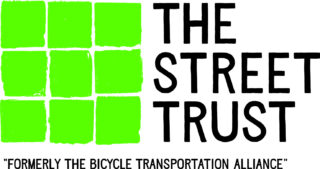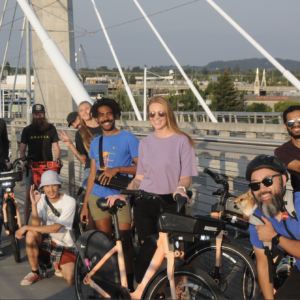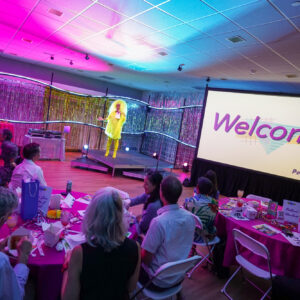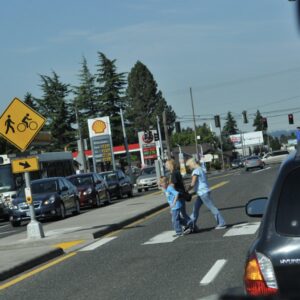
After 26 years as the Bicycle Transportation Alliance, the Portland-based advocacy organization is now officially known as The Street Trust.
Actually, according new Communications Director Kate Walker, the name is now, “The Street Trust, formerly The Bicycle Transportation Alliance.” That “formerly” part will remain for the rest of this year.
You might recall that the name change was ratified by the organization’s board and members back in August. But the new name wasn’t fully integrated into the brand until the new year. “With a new year, we’re finally ready to reveal our new brand,” reads a blog post about the change posted on January 4th.
Advertisement
The change in name comes with an expanded mission. Where the BTA used to be a cycling-centric group, The Street Trust (TST) will also take on issues faced by people who walk and take transit. With that expanded focus they have embarked on an effort to revamp their long-term strategic plan. There’s an event tomorrow (1/10) where all members are invited to give input on where TST should go from here.
TST has also confirmed they will add a 501(c)4 entity to the mix that will allow them to do more direct political lobbying. Adding a Political Action Committee to get even more engaged with issues and elections is under consideration.
Stay tuned for more information on the changes, including release of the organization’s 2017 goals.
— Jonathan Maus: (503) 706-8804, @jonathan_maus on Twitter and jonathan@bikeportland.org
BikePortland is supported by the community (that means you!). Please become a subscriber or make a donation today.






Thanks for reading.
BikePortland has served this community with independent community journalism since 2005. We rely on subscriptions from readers like you to survive. Your financial support is vital in keeping this valuable resource alive and well.
Please subscribe today to strengthen and expand our work.
“Where the BTA used to be a cycling-centric group, The Street Trust (TST) will also take on issues faced by people who walk and take transit.”
I guess we have solved all the cycling issues…..
Where did you read that?
“Where the BTA used to be a cycling-centric group, The Street Trust (TST) will also take on issues faced by people who walk and take transit.”
Rather than being centric, and perhaps unwittingly pitting traffic modes against each other, TST is set to take a holistic approach to having streets be more functional for all modes of street travel. That means more people from all travel mode groups, rather than just one, brought together to work on improving the overall travel system.
Cycling is not like walking.
Cycling is not like getting on a Max Train or bus.
If the Street Trust thinks they are, that is a problem…..
For once, I actually agree with you. The focus away from cycling specifically should be seen as a problem and a warning of things to come. Even cycling-friendly countries have cycling advocacy groups – the Fietsersbond in the Netherlands, for example. Let’s hope that BikeLoudPDX can step in to fill the void.
When I think of cycling, I think of fast road bikes with skinny tires. Maybe that’s your problem… When I bike commute, I use a lot of the same things pedestrians use. When I cycle, I don’t encounter too many people walking around out past the west hills.
The push to get more buses on north / south streets needs results this month. Not many buses on those kinds of streets in east Portland or many Washington county roads.
Don’t we already have organizations that lobby for better walking facilities and better public transport? What is the “Street Trust” bringing to the table that Oregon Walks and OPAL BRU haven’t already?
I think it is more likely that they want to target the money that is currently going to those other organizations.
Bingo.
Always follow the money.
A history of lawsuits that resulted in bike access on NE Wheeler Ave adjacent to the Moda Center.
While historically the BTA has had some big wins by suing/threatening to sue the St. Johns Bridge saga has shown that they are no longer willing to use that stick to try to advance safety, and they haven’t been for some time. I don’t think that is going to change as they try to expand their reach. The days of the BTA suing ODOT are long gone, and at this point they can’t even get anywhere by threatening such an action because no one thinks they are seriously going to sue.
The BTA has gone mainstream/non-confrontational enough that it might as well broaden its base to include other user groups opposed to automotive domination.
They stopped being a real bike advocacy group a long time ago, and fortunately BikeLoudPDX! has started to fill that vacuum. There is plenty of room for both.
The bicycle non-profit has finally awoken to the fact that real progress in bicycle infrastructure cannot move forward unless discussions about pedestrian and public transportation policy occur simultaneously. The city is pushing for multimodal forms of transportation. Walk to bikeshare, ride to the Max, walk to office/factory. The system will work much better if all three modes of transportation are integrated. NGO’s need to work on policies that promote congruency between the various modes of transportation.
There’s also a lot of stigma on the part of grantors, especially from foundations, against organizations that have “bicycle”, “pedestrian”, or “transit” in their name. “The Street Trust” is very nicely neutral, vague, and nonsensical – perfect for grant applications of any sort.
You make a fair point Matt, but this is really confusing things. I mean, if your name is BTA and everyone knows it and you have a clear mandate, why would you decide to throw it all away on a horrible name and wordart logo.
You can spin it every which way but it is just not progress.
i guess the netherlands, denmark, germany, and sweden are all doing it wrong.
real progress in public transportation policy cannot move forward unless discussions about bicycle infrastructure occur simultaneously.
real progress in pedestrian infrastructure cannot move forward unless discussions about bicycle infrastructure occur simultaneously.
i’m willing to bet that my reversals would make some bristle just like your statement made me bristle.
active transportation advocacy does not need to wave the white flag of surrender to “bikelash”. genuine bike infrastructure improvements can occur without being tied to concurrent transit or pedestrian improvements (at least if one believes that cycling has the potential to become a major transportation mode).
Bike infrastructure is totally unique from walking and transit.
The Tillikum and south waterfront is what happens when planners think they are similar.
A cluster*uck for all….
Right, but planning and construction costs dramatically increase when you have to bifurcate everything. If people were just a little more patient while using MUP’s, they’d work a lot better. Things break down when a cyclist believes he/she has the right away to cruise through the south waterfront uninhibited at 20 mph. There’s so many people around there. You just have to get use to cruising through at 8-10 mph.
I agree, all the signage, cables, green paint, people, bicycles, street cars, cars, buildings, raised sidewalks, splitting streets, overpasses, bikeshare stations, restaurants, etc. do make for a cluster muck. I just slow down and know I can’t be in a hurry to get through there.
“Things break down when a cyclist believes he/she has the right away to cruise through the south waterfront uninhibited at 20 mph. There’s so many people around there. You just have to get use to cruising through at 8-10 mph.”
If I need to ride at 8-10 mph, I will drive a car.
I ride a bike so I can get to where I want faster, not slower.
“….If I need to ride at 8-10 mph, I will drive a car. I ride a bike so I can get to where I want faster, not slower. …’ dwk
How fast do you want to ride? If you want to ride faster than 8-10mph, take the street. Downtown continues to get more bike lanes if you don’t like riding only in the main lanes of the road.
Downtown and surrounding neighborhoods should have more MUPs and esplanades. Probably should be even bigger and wider than the Waterfront and eastside esplanades, allowing better, easier and more comfortable use by people walking, biking, and skating. TST with its new priority focus, could possibly gather the interest of many more people in support of such things and more.
MUP’s are a bane of urban cycling.
I rode on a MUP every day in Chicago. It wasn’t perfect but it was far better than any offering in the street itself.
Outside of rush hour, a car is always faster in Portland. Stop it with the hyperbole.
Except when it snows. Except when there’s a crash on the highway. Except when your car breaks down. Except when there’s a protest. Except…
I commute out to east Portland, so right now, the exact opposite is true. Traffic has been light with many people choosing to stay home to avoid the ice. I haven’t seen a single cyclist east of 181st because the bike lanes are covered in an inch of ice. Cars are flowing normally, though. And we have many days out here where the wind rips out of the gorge at 30+mph. That adds 5 minutes to my bike commute, but doesn’t affect the car drivers at all. You people need to get out of your inner-Portland bubble.
Sometimes faster, sometimes not. When you factor in dress-down-time, ride-time, get-ready-for-office-time. And then do it all over for the commute home, I’d say the car is faster. You only have to change once in the morning and that’s out of your pajamas! However, traffic is the wild card which makes riding faster a lot of times. In my personal experience.
For my commute, in the order of the fastest:
Biking
Car
Running
Transit
Walking
I ride from NE Portland to Washington Square 5 days a week.
I do it in 50 minutes.
Try driving it in that time.
lol I can’t even get to NE Portland from SE Portland in under 50 mins.
I average about 15mph. Not that hard to do. Averaging 15mph is getting hard to do in a car in Portland.
Does that include from the moment you exit your door to the moment you sit down and start doing work on the clock. Gotta be nitpicky with time considering this is what we’re talking about.
I find that driving can be be a net gain of time because of the whole changing the clothes thing. When I ride, I have to wear athletic clothing or the ride is miserable, not to mention it wears my pants out in the crouch quick.
So I have to get dressed for bike commute, then get to the office, change into office clothes (you know to look professional on that, blah). Then end of the day, change again, ride home. And then change again into casual clothing! The hassle can be a bit of a groundhogs day.
I agree though, I’d much rather bike commute than drive. Driving is stressful and I’m terrified that I’m going to hit a pedestrian/bike commuter one of these dark stormy nights.
Add another 10 minutes for changing clothes. 1 hour total to cross the city.
The car commute was faster about 2 years ago but not now. Cycling is SO much better…..
I don’t wear special clothing to ride a bicycle and thus have no need to change clothes when I get to work.
I also know within a minute or 2 when I will get home or to work. It never varies like driving or transit does.
I agree dwk.
I could drive there in 30 minutes right now. Even during rush hour traffic, there are enough alternate routes that one could easily get there in under an hour.
hilarious……
If you leave right now, it will take you 30 minutes to get across the river, but be my guest.
Biking, walking and transit ride share a common enemy: excessive automobile reliance. The enemy of my enemy is my friend.
I’m just saying, when you improve the bike lane to the Max station, you inadvertently make the transportation system better as a whole. Funding for bicycle infrastructure doesn’t necessarily need to be tethered to pedestrian and transit development to move projects forward. But when you’re standing in front of a committee advocating for money and you can talk about the benefits of that bike lane and the affects it has not just on cyclists but moving people around more efficiently, more people may lend their ears.
The problem is that bike infrastructure is so cheap, so it rarely attracts the big funding that our capital-hungry transportation culture loves to hand out. If we can get good bike infra out of large public transport projects, then great. However, this should not be the sole funding method – especially considering federal funding for large capital projects is likely to dry up very soon. Ideally, we’d have a local source that is guaranteed for bike projects – a fixed percentage of local gas tax, for example.
Thanks for the update…I was beginning to wonder what was up in late December after visiting the BTAs still active webpage.
Todd, we are currently updating our website, and as it takes a long time to do that with a small staff, it’ll be an ongoing process for a while. Thanks for your patience!
Unnecessary quotation marks in their logo. A quibble, but come on!
Looks like they’re quoting someone named New Iogo
I hope for some early victories so they can gain “Street Cred”.
OK… Your Mission… You MUST accept it… Get Oregon to make roads and sidewalks safe for people to use.
On the road:
Change the law on storm drain grates. Unsafe grates have been illegal in Oregon since 1971, except for those installed prior to then. They’ve had over 40 years of grandfathering. Grandpa’s DEAD people, let’s eliminate this from his legacy.
On sidewalks:
No large cracks, heaves, hidden lips (tripping hazards). Get more enforcement on this.
Force the stage to install ADA compliant storm drain grates in pedestrian areas (I’m looking at you Portland Saturday Market, Rose Quarter Transit Center, Pioneer Courthouse Square, and PSU). It is the LAW and has been for over 25 years.
Compel the state’s communities to install proper ADA ramps everywhere. While I was riding around in Portland, I was constantly finding sidewalks without ramps.
and get the State of Oregon to BAN black locust trees from ANY planting ESPECIALLY on ODOT land (Medford take notice (Garfield St/Highland Dr.)(You too Region 2 (SW 4th and Caruthers/SW Broadway). Black locust trees are not native to the region, they are invasive, they are toxic, they destroy sidewalks, and have strong 2″ long sharp thorns at regular intervals capable of putting out someone’s eyes. Not everybody can see them (there is something called “Blindness”)(So don’t turn your eyes away from this).
Your people will acknowledge you, and thank you for your work.
stupid auto correct… “Force the State to install”
The Raleigh Hills Fred Meyer has not removed the toxic Tree of Heaven on Scholls Ferry road by their property.
If they’re going to accomplish this impossible mission, they’re going to need some really cool gadgets and clever Nimoy-like staff.
Like a chainsaw, some rulers, cameras (even a small spy camera would do), and enough people behind them saying thing like… “You know, this isn’t rocket science to make sidewalks and streets safer. It’s common sense”.
and lawyers pointing out to them that it’s also a lot more economical for the community to fix things voluntarily, than it is to wait for someone to get hurt, the resulting lawsuits, damages and restitution, then be FORCED to fix these things.
Sorry, but this is a really dumb name.
Yes no doubt. 😉
When I lived in NYC, I supported an organization called Transportation Alternatives. Looks like they are still around: (https://www.transalt.org/) and they support better cycling, walking, and transit. I like the name b/c it says what their goal is – to provide alternatives for transportation, not just cars. A minute ago I told someone “BTA is changing its name to The Street Trust” and she replied, “Is it to support homeless people?” Anyway, probably BTA thought of these things before they changed the name, so good luck to them and to us.
Do the nine green squares have a backstory?
a rubix cube reference perhaps?
I took it to be a street grid (map view), or a tic-tac-toe board.
IMO, it looks like the 9 fluorescent green sticky notes they used to brainstorm a new name and logo without a budget.
comment of the day?!
Comment of the week!
Looks to me like an overhead view of Downtown Portland’s 200′ square block grid. I like the color, the font used for the words, and the overall logo. Much better than the former. This, and the organizations reviewed and revised direction is progress, and an improvement over the narrow, in some sense, missed opportunity of the former bta’s objective priorities.
My hope is that this will trigger the development of an effective bicycle advocacy organization, something the BTA hasn’t been for quite a while. Didn’t they receive funds from the bicycle license plates? Could this be given to a bicycle organization?
This whole rebranding makes no sense. The logo sucks. The name sucks. And their mission sounds like the product of some stupid echo chamber groupthink exercise.
the public transit has stalled in the portland area
Tell us how you really feel.
Several years ago, a friend pointed out to me that we once had bike paths, then they became shared use paths and they are rapidly becoming off-street sidewalks. (The difference here is that on bike paths bikes have the right of way, on sidewalks pedestrians have the right of way; we’re there now with current interpretations).
I guess we also once had bicycle advocacy organizations that had the drive and courage to sue the powers that be. Now we have an organization advocating for all transportation forms that has been co-opted by the powers that be.
I’m not criticizing the BTA for their change. I understand where they’re coming from. I’m still sad that the mighty bicycle is no longer viewed as a sufficient game-changer even though we have barely begun to rediscover its potential.
Thanks to BTA the offstreet bike paths are now only places that cyclists can ride on if the pedestrians who are listening on their earbuds while texting allow the cyclist to pass.
Peds have unrestricted right of way on bike paths
ummmm… Is THAT the logo? and name? wow.
“Very trusty folk”
As for the name… I like the sound of “Better Transportation Alternatives”
@Beth H. The suns going super nova someday and will destroy the entire solar system. What’s the point of doing anything then, really…
The sun is more likely to go “nova” than “supernova…” in 4 billion years. By that time we all should be able to move to the recently deduced “planet 9,” which, according to my calculations, resides 50 billion miles from earth.
As long as the automobile is king everywhere, then bicycles, public transit and walking will always be seen as “alternative” rather than “primary,” and therefore the realm of Those Who Cannot Drive. If yoou cannot (or will not) drive, then you are seem as less adult, less responsible, less desirable and less worthy of consideration. Don’t believe me? Pick up any mainstream magazine or newspaper and look at the ads. Look at the way that automotive travel continues to be heavily subsidized in this country, and how hard it is to pass a new gas tax anywhere.
And then tell me that this new organization will actually accompish anything besides seiziing “market share” for limited grant and donation dollars.
The BTA lost me long before the name and focus change. I am not part of their constituency and they’ve now made that patently clear.
While their methods may not please everyone, my money is on the folks at BikeLoudPDX, and anyone else who wants to live a car-free or car-lite life out loud.
Car reliance cannot last forever, nor should it. Working within the mainstream will take longer than our planet has. Anyone who has the courage of their convictions to stand up and say that, and to advocate/educate/agitate from that position gets my support.
As much as I love cycling, it’s not a complete antidote to what ails cities. It’s not even the main one. In most cities, the principle alternative to cars — based on modal share — is public transport. Even in Amsterdam, where they’ve worked tirelessly to improve cycling conditions for 100 years, the modal share for public transport is close to the one for cycling.
The problem with urban transport generally, and certainly in Portland, is that it relies too much on single-passenger cars. To get past this, people need multiple alternatives — ones that work for short and long distances, day and night, in good and bad weather, for shopping and commuting, for the old and young, the fit and not-so-fit. So to me, it makes a lot of sense that there’s a group that’s advocating for all this. I don’t understand the tribalism that the BTA move has stirred up.
Get out of here with your reasonable, balanced views. Can’t you see this is a place for purists?
Amsterdam has a cycling-specific advocacy group, so I’m not sure what your point is here. Yes, public transport is important, but there’s no reason why we can’t have separate organizations with discretely focused goals that work together. You think the BTA didn’t care about walking and public transport before changing names? This is all about attracting a bigger pool of fundraising, that’s it.
And Portland still has at least one group dedicated to cycling only. Seems like the emergence of a general sustainable transport group is added value. And if the new focus/branding brings more donors to the cause, that’s not necessarily a bad thing is it?
comparing small all volunteer groups to the political juggernaut that is fietsersbond amsterdam is wishful thinking to an extreme.
cycling mode share in amsterdam is double that of public transport:
http://www.iamsterdam.com/en/media-centre/city-hall/dossier-cycling/cycling-facts-and-figures
Lame new name. Sounds like some new monopoly corporation on Wall Street. “The Street Trust” doesn’t say bikes, peds or buses. Doesn’t say Oregon. Doesn’t say anything. Could be the new name for an asphalt lobbying group. Maybe that’s where they’re heading.
Looking over their website, I see a lot of feel-good programs that are “safe” but not any mention of what they’re going to do about the culture of hazardous driving. If they were a bit more radical, they could maybe gain a lot more donations from members and be less reliant on big donors. I doubt I’ll be willing to participate as long as they aren’t confronting driving culture or doing anything about lax traffic enforcement.